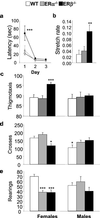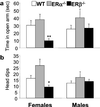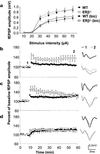Increased anxiety and synaptic plasticity in estrogen receptor beta -deficient mice
- PMID: 11593044
- PMCID: PMC59805
- DOI: 10.1073/pnas.221451898
Increased anxiety and synaptic plasticity in estrogen receptor beta -deficient mice
Abstract
Estrogens are powerful modulators of neuronal physiology and in humans may affect a broad range of functions, including reproductive, emotional, and cognitive behaviors. We studied the contribution of estrogen receptors (ERs) in modulation of emotional processes and analyzed the effects of deleting ERalpha or ERbeta in mice. Behavior consistent with increased anxiety was observed principally in ERbeta mutant females and was associated with a reduced threshold for the induction of synaptic plasticity in the basolateral amygdala. Local increase of 5-hydroxytryptamine 1a receptor expression in medial amygdala may contribute to these changes. Our data show that, particularly in females, there is an important role for ERbeta-mediated estrogen signaling in the processing of emotional behavior.
Figures




Similar articles
-
Activation of estrogen receptor-beta regulates hippocampal synaptic plasticity and improves memory.Nat Neurosci. 2008 Mar;11(3):334-43. doi: 10.1038/nn2057. Epub 2008 Feb 24. Nat Neurosci. 2008. PMID: 18297067
-
Lack of functional estrogen receptor beta influences anxiety behavior and serotonin content in female mice.Physiol Behav. 2005 Jan 31;84(1):157-63. doi: 10.1016/j.physbeh.2004.11.002. Epub 2004 Dec 8. Physiol Behav. 2005. PMID: 15642619
-
Estradiol enhances primary antigen-specific CD4 T cell responses and Th1 development in vivo. Essential role of estrogen receptor alpha expression in hematopoietic cells.Eur J Immunol. 2003 Feb;33(2):512-21. doi: 10.1002/immu.200310027. Eur J Immunol. 2003. PMID: 12645950
-
Estrogen signaling: a subtle balance between ER alpha and ER beta.Mol Interv. 2003 Aug;3(5):281-92. doi: 10.1124/mi.3.5.281. Mol Interv. 2003. PMID: 14993442 Review.
-
Estrogen receptor knockout mice: phenotypes in the female reproductive tract.Gynecol Endocrinol. 2003 Apr;17(2):169-76. Gynecol Endocrinol. 2003. PMID: 12737678 Review.
Cited by
-
Estrogen dependent activation function of ERβ is essential for the sexual behavior of mouse females.Proc Natl Acad Sci U S A. 2012 Nov 27;109(48):19822-7. doi: 10.1073/pnas.1217668109. Epub 2012 Nov 12. Proc Natl Acad Sci U S A. 2012. PMID: 23150547 Free PMC article.
-
Estrogen Enhances Dendrite Spine Function and Recovers Deficits in Neuroplasticity in the prpTDP-43A315T Mouse Model of Amyotrophic Lateral Sclerosis.Mol Neurobiol. 2022 May;59(5):2962-2976. doi: 10.1007/s12035-022-02742-5. Epub 2022 Mar 6. Mol Neurobiol. 2022. PMID: 35249200 Free PMC article.
-
17 Beta-estradiol-induced antidepressant-like effect in the forced swim test is absent in estrogen receptor-beta knockout (BERKO) mice.Psychopharmacology (Berl). 2005 May;179(3):637-43. doi: 10.1007/s00213-004-2078-1. Epub 2005 Jan 6. Psychopharmacology (Berl). 2005. PMID: 15645223
-
The influence of estrogen receptor α signaling independent of the estrogen response element on avoidance behavior, social interactions, and palatable ingestive behavior in female mice.Horm Behav. 2021 Nov;136:105084. doi: 10.1016/j.yhbeh.2021.105084. Epub 2021 Oct 30. Horm Behav. 2021. PMID: 34749278 Free PMC article.
-
Differential activation of Gsk-3β in the cortex and the hippocampus induces cognitive and behavioural impairments in middle-aged ovariectomized rat.Compr Psychoneuroendocrinol. 2020 Nov 30;4:100019. doi: 10.1016/j.cpnec.2020.100019. eCollection 2020 Nov. Compr Psychoneuroendocrinol. 2020. PMID: 35755628 Free PMC article.
References
-
- Genazzani A R, Spinetti A, Gallo R, Bernardi F. Maturitas. 1999;31:103–110. - PubMed
-
- Joffe H, Cohen L S. Biol Psychiatry. 1998;44:798–811. - PubMed
-
- Soares C N, Almeida O P, Joffe H, Cohen L S. Arch Gen Psychiatry. 2001;58:529–534. - PubMed
-
- Gupta R R, Sen S, Diepenhorst L L, Rudick C N, Maren S. Brain Res. 2001;888:356–365. - PubMed
-
- Shughrue P J, Lane M V, Merchenthaler I. Endocrinology. 1999;140:2613–2620. - PubMed
Publication types
MeSH terms
Substances
LinkOut - more resources
Full Text Sources
Other Literature Sources
Medical
Molecular Biology Databases

